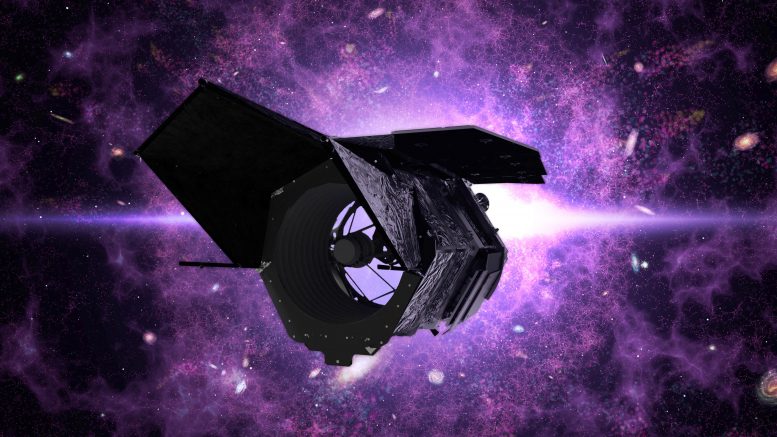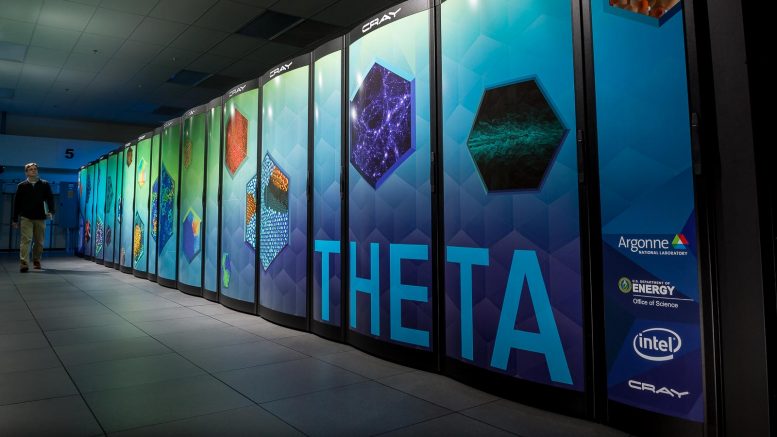
This graphic highlights part of a new simulation of what NASA’s Nancy Grace Roman Space Telescope could see when it launches by May 2027. The background spans about 0.11 square degrees (roughly equivalent to half of the area of sky covered by a full Moon), representing less than half the area Roman will see in a single snapshot. The inset zooms in to a region 300 times smaller, showcasing a swath of brilliant synthetic galaxies at Roman’s full resolution. Having such a realistic simulation helps scientists study the physics behind cosmic images –– both synthetic ones like these and future real ones. Researchers will use the observations for many types of science, including testing our understanding of the origin, evolution, and ultimate fate of the universe. Credit: C. Hirata and K. Cao (OSU) and NASA’s Goddard Space Flight Center
Researchers at the U.S. DOE’s Argonne National Laboratory have created nearly 4 million simulated images of the cosmos for the Nancy Grace Roman Space Telescope and the Vera C. Rubin Observatory.
This simulation, part of the OpenUniverse project, was achieved using supercomputers and provides a highly accurate preview of how these telescopes will observe the universe. The simulations are crucial for studying dark matter and dark energy, and help scientists prepare for real observations starting in 2025 for Rubin and 2027 for Roman.
Scientists are diving into a synthetic universe to help us better understand the real one. Using supercomputers at the U.S. DOE’s (Department of Energy’s) Argonne National Laboratory in Illinois, scientists have created nearly 4 million simulated images depicting the cosmos as NASA’s Nancy Grace Roman Space Telescope and the Vera C. Rubin Observatory, jointly funded by NSF (the National Science Foundation) and DOE, in Chile, will see it.

The Roman Space Telescope is a NASA observatory designed to unravel the secrets of dark energy and dark matter, search for and image exoplanets, and explore many topics in infrared astrophysics. Credit: NASA
Advanced Simulation Techniques for Observing the Cosmos
Michael Troxel, an associate professor of physics at Duke University in Durham, North Carolina, led the simulation campaign as part of a broader project called OpenUniverse. The team is now releasing a 10-terabyte subset of this data, with the remaining 390 terabytes to follow this fall once they’ve been processed.
“Using Argonne’s now-retired Theta machine, we accomplished in about nine days what would have taken around 300 years on your laptop,” said Katrin Heitmann, a cosmologist and deputy director of Argonne’s High Energy Physics division who managed the project’s supercomputer time. “The results will shape Roman and Rubin’s future attempts to illuminate dark matter and dark energy while offering other scientists a preview of the types of things they’ll be able to explore using data from the telescopes.”

View of Rubin Observatory at sunset in May 2024, on Cerro Pachón in Chile. Credit: Olivier Bonin/SLAC National Accelerator Laboratory
Unveiling the Universe’s Secrets Through Simulation
For the first time, this simulation factored in the telescopes’ instrument performance, making it the most accurate preview yet of the cosmos as Roman and Rubin will see it once they start observing. Rubin will begin operations in 2025, and NASA’s Roman will launch by May 2027.
The simulation’s precision is important because scientists will comb through the observatories’ future data in search of tiny features that will help them unravel the biggest mysteries in cosmology.
Roman and Rubin will both explore dark energy – the mysterious force thought to be accelerating the universe’s expansion. Since it plays a major role in governing the cosmos, scientists are eager to learn more about it. Simulations like OpenUniverse help them understand signatures that each instrument imprints on the images and iron out data processing methods now so they can decipher future data correctly. Then scientists will be able to make big discoveries even from weak signals.
“OpenUniverse lets us calibrate our expectations of what we can discover with these telescopes,” said Jim Chiang, a staff scientist at DOE’s SLAC National Accelerator Laboratory in Menlo Park, California, who helped create the simulations. “It gives us a chance to exercise our processing pipelines, better understand our analysis codes, and accurately interpret the results so we can prepare to use the real data right away once it starts coming in.”
Then they’ll continue using simulations to explore the physics and instrument effects that could reproduce what the observatories see in the universe.

This photo displays Argonne Leadership Computing Facility’s now-retired Theta supercomputer. Scientists use supercomputers to simulate experiments they can’t conduct in real life, such as creating new universes from scratch. Credit: Argonne National Laboratory
Telescopic Teamwork
It took a large and talented team from several organizations to conduct such an immense simulation.
“Few people in the world are skilled enough to run these simulations,” said Alina Kiessling, a research scientist at NASA’s Jet Propulsion Laboratory (JPL) in Southern California and the principal investigator of OpenUniverse. “This massive undertaking was only possible thanks to the collaboration between the DOE, Argonne, SLAC, and NASA, which pulled all the right resources and experts together.”
And the project will ramp up further once Roman and Rubin begin observing the universe.
“We’ll use the observations to make our simulations even more accurate,” Kiessling said. “This will give us greater insight into the evolution of the universe over time and help us better understand the cosmology that ultimately shaped the universe.”

This pair of images showcases the same region of sky as simulated by the Vera C. Rubin Observatory (left, processed by the Legacy Survey of Space and Time Dark Energy Science Collaboration) and NASA’s Nancy Grace Roman Space Telescope (right, processed by the Roman High-Latitude Imaging Survey Project Infrastructure Team). Roman will capture deeper and sharper images from space, while Rubin will observe a broader region of the sky from the ground. Because it has to peer through Earth’s atmosphere, Rubin’s images won’t always be sharp enough to distinguish multiple, close sources as separate objects. They’ll appear to blur together, which limits the science researchers can do using the images. But by comparing Rubin and Roman images of the same patch of sky, scientists can explore how to “deblend” objects and implement the adjustments across Rubin’s broader observations. Credit: J. Chiang (SLAC), C. Hirata (OSU), and NASA’s Goddard Space Flight Center
The Roman and Rubin simulations cover the same patch of the sky, totaling about 0.08 square degrees (roughly equivalent to a third of the area of sky covered by a full Moon). The full simulation to be released later this year will span 70 square degrees, about the sky area covered by 350 full Moons.
Overlapping them lets scientists learn how to use the best aspects of each telescope – Rubin’s broader view and Roman’s sharper, deeper vision. The combination will yield better constraints than researchers could glean from either observatory alone.
“Connecting the simulations like we’ve done lets us make comparisons and see how Roman’s space-based survey will help improve data from Rubin’s ground-based one,” Heitmann said. “We can explore ways to tease out multiple objects that blend together in Rubin’s images and apply those corrections over its broader coverage.”
Scientists can consider modifying each telescope’s observing plans or data processing pipelines to benefit the combined use of both.
“We made phenomenal strides in simplifying these pipelines and making them usable,” Kiessling said. A partnership with Caltech/IPAC’s IRSA (Infrared Science Archive) makes simulated data accessible now so when researchers access real data in the future, they’ll already be accustomed to the tools. “Now we want people to start working with the simulations to see what improvements we can make and prepare to use the future data as effectively as possible.”
OpenUniverse, along with other simulation tools being developed by Roman’s Science Operations and Science Support centers, will prepare scientists for the large datasets expected from Roman. The project brings together dozens of experts from NASA’s JPL, DOE’s Argonne, IPAC, and several U.S. universities to coordinate with the Roman Project Infrastructure Teams, SLAC, and the Rubin LSST DESC (Legacy Survey of Space and Time Dark Energy Science Collaboration). The Theta supercomputer was operated by the Argonne Leadership Computing Facility, a DOE Office of Science user facility.
The Nancy Grace Roman Space Telescope, named after NASA’s first chief of astronomy, is a future observatory set to launch in the mid-2020s. It aims to explore dark energy, exoplanets, and infrared astrophysics, providing a wider field of view than the Hubble Space Telescope and employing advanced technology like a coronagraph to directly image exoplanets. The mission is designed to answer key questions in cosmology and expand our understanding of the universe.
The Vera C. Rubin Observatory, previously known as the Large Synoptic Survey Telescope (LSST), is designed to conduct a 10-year Legacy Survey of Space and Time (LSST) to map the entire visible sky in unprecedented detail. Located in Chile, this observatory will utilize a wide-field telescope and a 3.2-billion-pixel camera to observe millions of galaxies and celestial phenomena, aiding in the study of dark matter, dark energy, and the formation of the Milky Way. Its extensive survey is expected to revolutionize our understanding of the universe and how it has evolved.
>>> Read full article>>>
Copyright for syndicated content belongs to the linked Source : SciTechDaily – https://scitechdaily.com/nasas-roman-space-telescope-gets-cosmic-sneak-peek-from-supercomputers/































